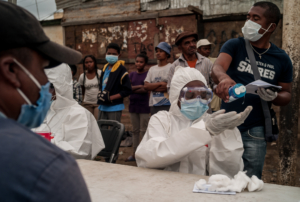Training Program For Health Workers in sub-Saharan Africa

Johnson & Johnson announced a new collaboration in June 2020, to provide training and knowledge to health workers in sub-Saharan Africa in the wake of COVID-19. They will partner with The World Continuing Education Alliance, The Aga Khan University School of Nursing and Midwifery East Africa and the International Council of Nurses to provide up-to-date information and resources to those on the front lines of the pandemic in sub-Saharan Africa.
The training program will be delivered through an application and aims to reach 600,000 healthcare workers — mainly nurses, doctors and midwives. The program includes six different modules available in three different languages: English, French and Arabic.
Partnering in 10 Different Countries
Johnson & Johnson will fund the programs’ introduction to 10 countries that it deems as a priority. These countries include Kenya, Uganda, Ethiopia, Tanzania, Rwanda, Nigeria, Ghana, Ivory Coast, Senegal and South Africa. Programs have since become available in Egypt, Haiti, Bangladesh, Afghanistan, Jordan, Guyana, Malawi and Tanzania — among others. Furthermore, there is a training option for countries not specifically listed.
Aga Khan University developed the modules and the World Continuing Education Alliance digitized and customized the curriculum. Its website now hosts two options for the workshops: one is for doctors and the other is for midwives and nurses. Through their collaborations with similar and broader-scope organizations, the International Council of Nurses has offered its support. The School of Nursing and Midwifery ensures those professionals in urban and remote areas alike have access to the modules.
Support For Front-Line Healthcare Workers
The new program’s introduction comes as the new coronavirus infections grow across Africa. The virus continues to infect more healthcare workers. While there are still scant resources available about infections among healthcare workers, the World Health Organization (WHO) estimates that over 10,000 health workers have been infected in 40 countries across Africa.
At least 10% of all infections are comprised of health workers in sub-Saharan Africa, concerning four specific countries. In 10 additional sub-Saharan countries, that figure is at least 5%. This puts a strain on the resources these countries have since several countries have less than one medical doctor for every 10,000 people. According to the WHO, countries that fall under this category include Mozambique, Tanzania, Guinea, Sierra Leone, Senegal, the Democratic Republic of the Congo, Somalia, Chad, Central African Republic and Niger — again, among others.
According to the WHO, some of the causes of rising infections among health workers include lack of access to personal protective equipment (PPE), lack of education programs (and lack of implementation of such programs with health workers) and lack of medical infrastructure. Additionally, more than 90% of 30,000 healthcare facilities analyzed throughout Africa could not establish quarantine or triage units. According to WHO, 84% of facilities did not have adequate infection and control measures in place.
Training Workers and Providing PPE
As a result, the WHO trained 50,000 healthcare workers and arranged for 41 million tons of PPE to be shipped to 47 countries in Africa. Moreover, the WHO plans to train 200,000 additional workers. The organization notes that from May to July 2020, Sierra Leone went from 16% of all infections being among health workers to just 9%.
Similar to the WHO, Johnson & Johnson’s collaborative effort seeks to educate health workers in sub-Saharan Africa by providing them with the knowledge they need to treat patients and stop the spread of a pandemic.
– Bryan Boggiano
Photo: Flickr
